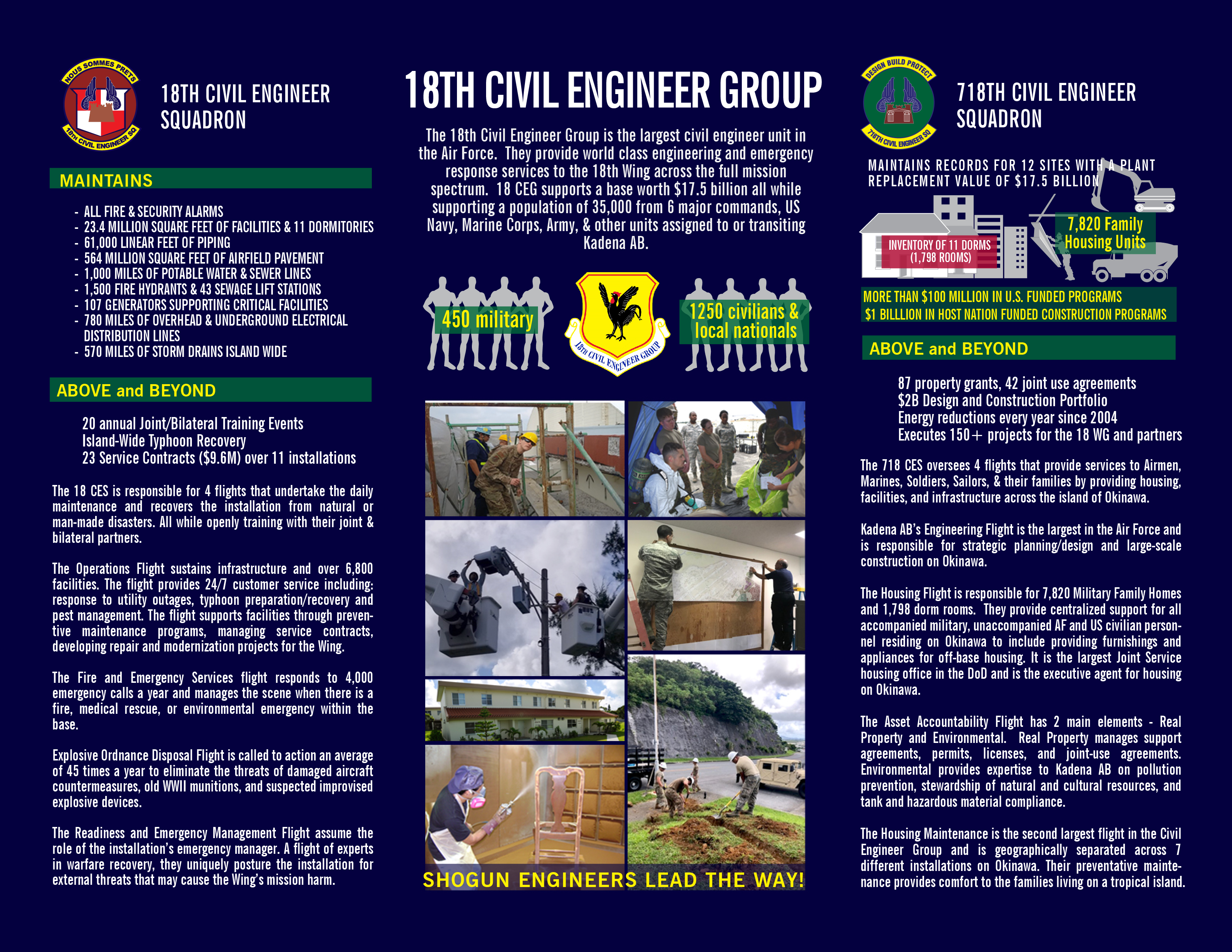
The 18th Civil Engineer Group is the largest civil engineer unit in the Air Force. It is comprised of two squadrons: the 18th and 718th, totaling more than 450 military, and 1,000 civilians and local nationals. Base support performed by the 18th CEG includes explosive ordnance disposal, fire and emergency services, environmental protection, maintenance and refuse contracts, housing and housing maintenance island-wide, and base infrastructure.
The 18th CES's Operations Flight maintains 23.4 million square feet of facilities, 17 dormitories, all fire and security alarms, jet fuel storage tanks, over 60,000 linear feet of piping, over 13 miles of aircraft fuel lines, over 100 generators supporting critical facilities, 1,000 miles of potable water and sewer lines including 1,500 fire hydrants and 43 sewage lift stations, 780 miles of overhead and underground electrical distribution lines, 570 miles of storm drains island wide and 564 million square feet of airfield pavement.
The 18th CES's Fire and Emergency Services Flight responds to an average of 4,000 emergency calls annually and manages the threat and outcome of fire, rescue medical and environmental emergencies.
The 18th CES's Maintenance Engineer Flight provides engineering expertise to the operations flight, support of infrastructure and facility projects, non-design drafting, service and utility contract management, recurring work program, and work analysis and improvement methods.
The 18th CES's Explosive Ordnance Disposal Flight responds to more than 50 munitions-related incidents/accidents and disposal operations per year. The flight saves and/or destroys damaged aircraft countermeasures, World War II ordnance still found on Okinawa, suspected improvised explosive devices, and nearby bombing and gunnery range clearances/surveys for target insertions.
The 18th CES's Readiness and Emergency Management Flight is the installation's emergency manager. The flight is composed of experts in chemical, biological, radiological, nuclear and high-yield explosive incident response/mitigation/training, in-garrison/deployed weapons of mass destruction response, hazardous material incident response, natural disasters and major accidents, and public health emergencies. The flight also conducts unit deployment manager activities.
The 718th CES Engineer Flight provides professional engineering services for all Kadena Air Base and associate units. Services include planning, programming, design, and construction activities. The flight directs more than $100 million in U.S. funded programs, $1 billion in host nation-funded construction programs, and provides state-of-the-art geospatial information systems operations.
The 718th CES Housing Flight provides support for military families from all branches of service on Okinawa to include U.S. civilians and provides housing for unaccompanied personnel. It is the largest Joint Service housing office in the DoD and is the executive agent for housing on Okinawa with an inventory of 17 dormitories at Kadena and more than 8,000 with housing units.
The 718th CES Housing Maintenance Flight Operates the largest in-house maintenance program in the Department of Defense. The flight actively maintains an inventory of 8,180 units and provides customer service 24 hours a day, 7 days a week.
The 718th CES Real Estate Flight coordinates interservice support agreements; prepares facility permits and licenses, joint-use agreements, Government of Japan land release processes and recommendations to the U.S. Forces Japan facilities sub-committee. The flight maintains records for 18 installations with a plant replacement value of $5.8 billion.
The 718th CES Environmental Flight provides professional environmental expertise to Kadena AB members in the area of pollution prevention, stewardship of natural and cultural resources, energy conservation and compliance with Japan Environmental Governing Standards and other regulatory requirements. The flight also disposes of hazardous wastes generated on base at initial accumulation points, manages tank compliance, coordinates hazardous material procurement, and protects Okinawan cultural assets to include shrines, tombs and historical sites.